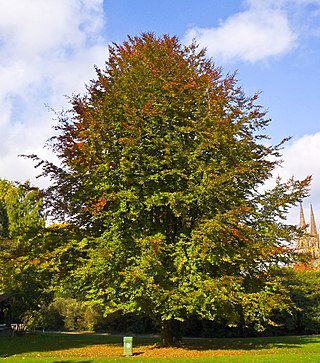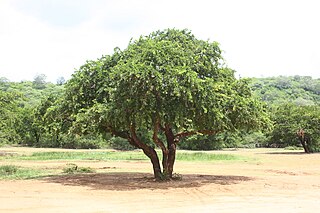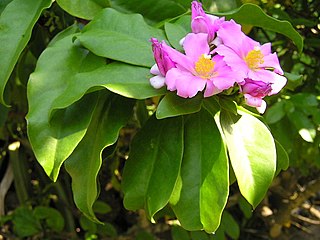
Kumquats, or cumquats in Australian English, are a group of small fruit-bearing trees in the flowering plant family Rutaceae. Their taxonomy is disputed. They were previously classified as forming the now-historical genus Fortunella or placed within Citrus, sensu lato. Different classifications have alternatively assigned them to anywhere from a single species, C. japonica, to numerous species representing each cultivar. Recent genomic analysis would define three pure species, Citrus hindsii, C. margarita and C. crassifolia, with C. x japonica being a hybrid of the last two.

Citrus is a genus of flowering trees and shrubs in the rue family, Rutaceae. Plants in the genus produce citrus fruits, including important crops such as oranges, lemons, grapefruits, pomelos, and limes. The genus Citrus is native to South Asia, East Asia, Southeast Asia, Melanesia, and Australia. Various citrus species have been used and domesticated by indigenous cultures in these areas since ancient times. From there its cultivation spread into Micronesia and Polynesia by the Austronesian expansion ; and to the Middle East and the Mediterranean via the incense trade route, and onwards to Europe and the Americas.

Calamansi, also known as calamondin, Philippine lime, or Philippine lemon, is an economically important citrus hybrid predominantly cultivated in the Philippines. It is native to the Philippines, Borneo, Sumatra, and Sulawesi in Indonesia in Southeast Asia, Malaysia as well as southern China and Taiwan in East Asia. Calamansi is ubiquitous in traditional Filipino cuisine. It is naturally very sour, and is used in various condiments, beverages, dishes, marinades, and preserves. Calamansi is also used as an ingredient in Malaysian and Indonesian cuisines.

The Fagaceae are a family of flowering plants that includes beeches, chestnuts and oaks, and comprises eight genera with about 927 species. Fagaceae in temperate regions are mostly deciduous, whereas in the tropics, many species occur as evergreen trees and shrubs. They are characterized by alternate simple leaves with pinnate venation, unisexual flowers in the form of catkins, and fruit in the form of cup-like (cupule) nuts. Their leaves are often lobed and both petioles and stipules are generally present. Their fruits lack endosperm and lie in a scaly or spiny husk that may or may not enclose the entire nut, which may consist of one to seven seeds. In the oaks, genus Quercus, the fruit is a non-valved nut called an acorn. The husk of the acorn in most oaks only forms a cup in which the nut sits. Other members of the family have fully enclosed nuts. Fagaceae is one of the most ecologically important woody plant families in the Northern Hemisphere, as oaks form the backbone of temperate forest in North America, Europe, and Asia, and are one of the most significant sources of wildlife food.

The Rutaceae is a family, commonly known as the rue or citrus family, of flowering plants, usually placed in the order Sapindales.

A lime is a citrus fruit, which is typically round, green in color, 3–6 centimetres (1.2–2.4 in) in diameter, and contains acidic juice vesicles.

The citron, historically cedrate, is a large fragrant citrus fruit with a thick rind. It is said to resemble a 'huge, rough lemon'. It is one of the original citrus fruits from which all other citrus types developed through natural hybrid speciation or artificial hybridization. Though citron cultivars take on a wide variety of physical forms, they are all closely related genetically. It is used in Asian cuisine, traditional medicines, perfume, and religious rituals and offerings. Hybrids of citrons with other citrus are commercially more prominent, notably lemons and many limes.

Fagus grandifolia, the American beech or North American beech, is a species of beech tree native to the eastern United States and extreme southeast of Canada.

The trifoliate orange, Citrus trifoliata or Poncirus trifoliata, is a member of the family Rutaceae. Whether the trifoliate oranges should be considered to belong to their own genus, Poncirus, or be included in the genus Citrus is debated. The species is unusual among citrus for having deciduous, compound leaves and pubescent (downy) fruit.

Citrus glauca, commonly known as the desert lime, is a thorny shrub or small tree native to Queensland, New South Wales, and South Australia. The 1889 book The Useful Native Plants of Australia records common names native kumquat and desert lemon.

Limonia acidissima is the only species within the monotypic genus Limonia. Common names for the species in English include wood-apple and elephant-apple. It is sometimes also called monkey fruit.

Rhodocactus grandifolius is a species of cactus native to eastern and southern Brazil. Like all species in the genus Rhodocactus and unlike most cacti, it has persistent leaves. It was first described in 1819. It is grown as an ornamental plant and has naturalized outside its native range.

Triphasia trifolia is a species of Triphasia in the family Rutaceae, native to tropical southeastern Asia especially in Indonesian islands and Philippines and possibly elsewhere.

Triphasia is a small genus of three species in the family Rutaceae, related to Citrus. The genus is native to southeastern Asia and New Guinea.

Clymenia is a small genus of flowering plants in the family Rutaceae with two species. The genus is often included in Citrus.
Triphasia brassii is a rare species of Triphasia in the family Rutaceae, native to New Guinea.

Clausena is a genus of flowering plants in the citrus family, Rutaceae. It was first defined by the Dutch botanist Nicolaas Laurens Burman in 1768. It is distributed in Africa, southern Asia, Australia, and the Pacific Islands.

Citrus taxonomy refers to the botanical classification of the species, varieties, cultivars, and graft hybrids within the genus Citrus and related genera, found in cultivation and in the wild.

Elysia grandifolia is a species of sea slug, a marine gastropod mollusc in the family Plakobranchidae native to the waters off southern India and Sri Lanka. It has colonised the waters of the eastern Mediterranean Sea.

Atalantia is a genus of flowering plants in the citrus family, the Rutaceae.


















